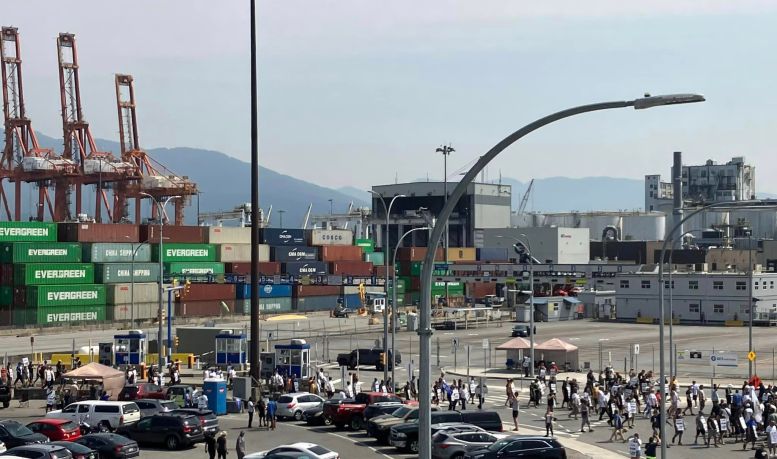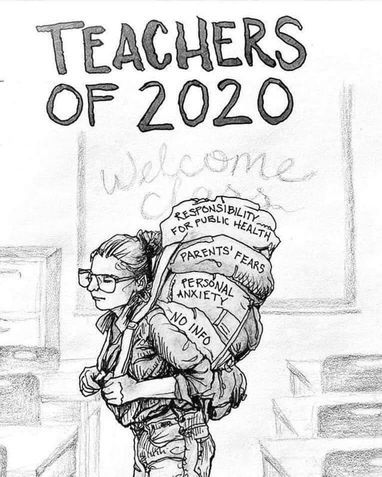This article was published in the latest issue of Socialist Alternative’s magazine. Since then, further strikes have erupted including ILWU at BC’s ports and 27 Metro stores around Toronto.
Over the last thirty years, academics and pundits have written off the working class, arguing that it has changed or disappeared. The last few years has shown how wrong they were, with major strike waves in many countries including France, Britain, Portugal, Iran, Myanmar, India, Colombia and others.
In the US, unions are more popular than at any time since 1965, with 71 percent support. This popularity has seen many move to unionize, including at Amazon, Starbucks, Apple stores and others. However, big business is determined to resist this basic democratic right, spending over $433 million a year to stop union drives.
Canada saw the most days lost in strikes in 2022 since 2009. This upturn in strikes was driven by private sector workers, with the most days lost in over 20 years. This year’s PSAC strike, the first since 2004 and longer lasting, will probably push the figures for 2023 to a similar level as 2022.
Attacking Workers
Over several decades, big business and governments attacked workers’ pay and conditions to boost profits. Laws were changed to reduce the democratic rights of unions to organize and strike. Factories in some of the richest countries were closed and jobs were moved to lower-wage economies. While this weakened unions in the rich countries, it greatly strengthened the working class around the world.
Real wages in the richer countries stagnated. Canadians’ real average hourly wages have not improved since 1981. The wealth went overwhelmingly to the rich and corporations. Between 1982 and 2018, the average income of the richest 1 percent doubled, while for the poorest 90 percent it stood still or even declined. Government tax cuts to the rich and big business boosted their wealth, robbing workers and the poor to give to the rich.
COVID made these trends worse, with job losses concentrated among low-income workers. “Essential workers,” who kept their jobs, such as in health facilities, food production and processing, transport and warehouses, and manufacturing, often had to work long hours in unsafe conditions with a higher risk of infection and exhaustion.
The Working Class is Back
The recent strikes have pushed the working class back into the public’s awareness although, contrary to claims, it never went away. Years of stagnant living standards, growing inequality and poor working conditions have piled up. Soaring inflation, with wages not keeping up, has made matters worse. The Bank of Canada keeps pushing up interest rates that further squeeze living standards as mortgage, rents and debt charges have soared. After decades of soaring house prices, average Canadians have one of the highest household debt burdens in the world. Workers have had enough.
Currently faced with a political impasse, with a choice between parties that support the failing status quo and right populists offering no way forward, workers are looking to make gains through workplace struggles.
Strikes and working-class mass struggle are growing more common — both for better wages and conditions, and for social and environmental justice. Climate activists are turning away from small individual actions to mass activity and linking with workers, an important step forward. Climate change’s many disasters are hitting many working-class people with fires, floods, storms and heat waves. Fridays for Future stated “climate struggle is class struggle.”
The many struggles of women for equality, reproductive rights and against sexual violence have organized strikes (with men also participating) in Latin America, Spain, Switzerland and Iceland.
Workers’ strikes and protests have been central in struggles for democratic rights and against state repression. Resistance to the Myanmar coup was led by strikes and mass protests of teachers, health workers, textile workers and others. The Iranian working class was an important part of the mass movement against state oppression. While these movements have so far not succeeded, they weakened the regimes and laid the foundation for future successful struggles.
Why the Working Class?
Marxists have always pointed to the working class as the key force to make change and that mass struggles were crucial to winning major reforms. This is not to romanticize the working class, which includes all of society’s prejudices. The working class makes things happen, as COVID clearly demonstrated. It is workers, not bosses or bankers, that feed society, keep the lights running and provide all the other vital services. Without workers, the bosses cannot make profits.
Social and economic changes have produced new groups of workers such as in tech and logistics. Currently most of these workers are not unionized but have enormous potential economic power and there are growing moves towards forming unions. A hundred years ago, longshoring was the ultimate gig employment. Every day, workers turned up at the docks looking for a day’s work, with the boss picking who they wanted, depending on the number of ships in harbour and which workers they liked. After titanic struggles, longshore workers built powerful unions. The same process will take place in the modern-day “dark satanic mills” of Amazon warehouses.
Working together produces shared experiences and common consciousness. Workers have collective grievances and struggle most effectively together as a workforce. Marx explained that the working class, through its shared experiences, comes to be not only a class “in itself,” but a class “for itself.” Of course, this process is not universal, inevitable or uniform. The bosses use ideology to deliberately foster multiple divisions, along the lines of gender, skill, public or private, religion and ethnicity. Good workers’ leaders work to unify the working class around a clear program that rejects concessions to the bosses.
Neoliberalism attacked class consciousness and solidarity, arguing instead for individualism. As Thatcher famously lied, “there is no society, only families and individuals.” Decades of neoliberalism’s failures to deliver better living standards, secure jobs or a healthy planet is a more powerful teacher than lectures in ideology. Workers and young people are increasingly looking to class struggle, solidarity and socialism.
Fighting Leadership Needed
One of the biggest obstacles that workers face to successful struggles is the so-called leadership of the unions and “left” political parties. Most of them still cling to neoliberal views that there is no alternative to capitalism. Therefore, they limit demands to what the bosses will agree to, rather than provide a clear program and strategy for working-class victories.
Some union leaders seem to think they should have the same lifestyle as the bosses rather than that of their members. Some even seem open to corruption in search of the good life. Some Canadian union leaders get over $200,000 a year, far more than their members.
Union leaders knowingly recommend bad pay deals such as the BCGEU in BC and CUPE in Ontario, in 2022. Laura Walton, CUPE leader in Ontario, stated that “as a worker, I don’t like this deal.” In both cases only a fraction of the strength of all the public sector in the province had been used to try and win a better contact. Many workers were unhappy with the new contracts, with large minorities voting to reject a below inflation pay agreement.
BC’s public sector workers were negotiating with an NDP government that claims to be on the side of workers, yet it would not agree to a wage increase in line with the cost of living. Although Trudeau forced PSAC workers into a two-week strike, and legislated port and postal workers to end strikes, still the federal NDP acts like the tail of the Liberal dog, not presenting any bold alternative policies that would benefit workers.
The looming world recession may temporarily reduce strikes and protests, as workers worry about losing their jobs. But it will make the economic misery worse and re-enforce awareness of capitalism’s failings. After a possible lull, the anger will re-emerge.
Socialist Alternative campaigns for policies that can help workers struggle and win, including:
- Fighting, democratic unions run by and for the membership to campaign for better working conditions and pay, including Cost-of-Living Adjustment (COLA) clauses in all contracts.
- Full-time union officials and representatives to be elected regularly from the membership, subject to recall and receive the same wages as those they represent.
- Unions to organize the unorganized with bold campaigns focused on youth, women, people of colour and migrant workers.
- Solidarity actions with the struggles of workers and the oppressed in Canada and internationally — an injury to one is an injury to all.
- Unions to play a leading role in building broader movements for social change and in the building of a mass workers’ party.




